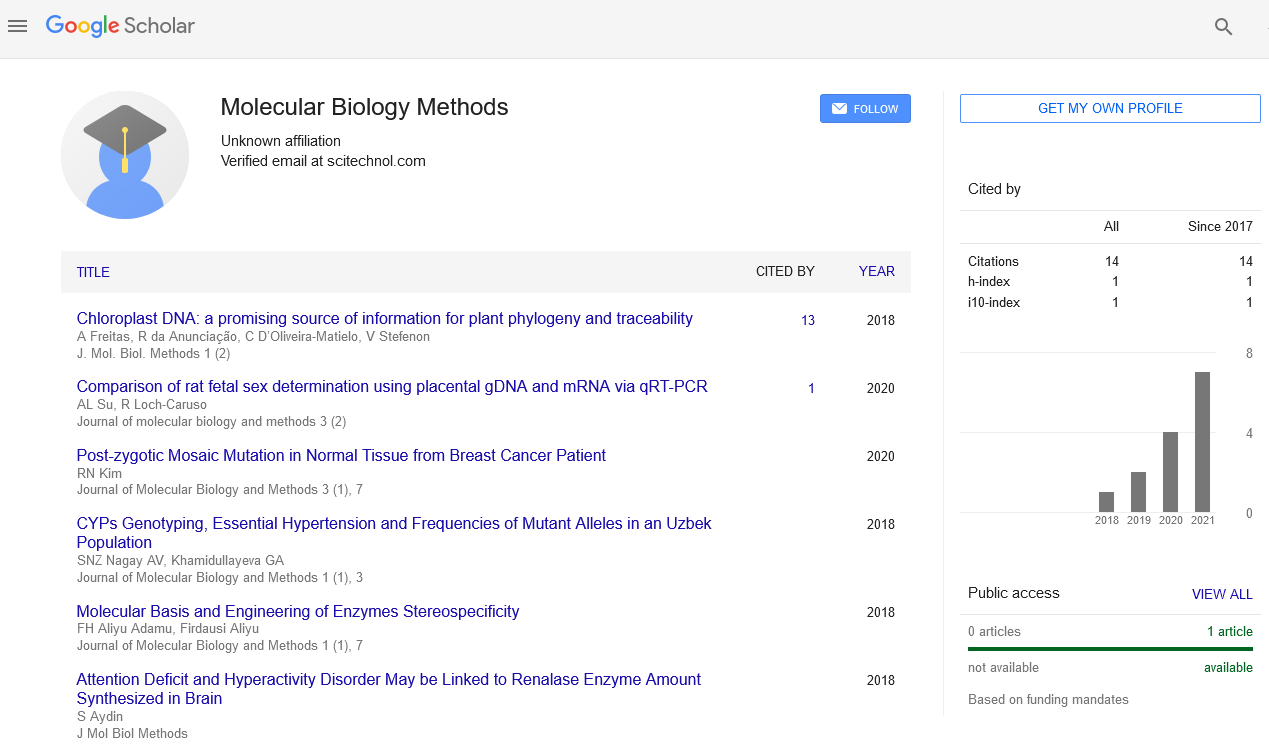Opinion Article, J Mol Biol Methods Vol: 7 Issue: 1
Exploring the Fundamentals and Applications of Gel Electrophoresis
Juan Hashimi*
1Department of Biology Sciences, University of South Bohemia, Budweis, Czech Republic
*Corresponding Author: Juan Hashimi,
Department of Biology Sciences,
University of South Bohemia, Budweis, Czech Republic
E-mail: hashimijuan@paru.cas.cz
Received date: 26 February, 2024, Manuscript No. JMBM-24-136933;
Editor assigned date: 29 February, 2024, PreQC No. JMBM-24-136933 (PQ);
Reviewed date: 14 March, 2024, QC No. JMBM-24-136933;
Revised date: 21 March, 2024, Manuscript No. JMBM-24-136933 (R);
Published date: 28 March, 2024, DOI: 10.4172/JMBM.1000153
Citation: Hashimi J (2024) Exploring the Fundamentals and Applications of Gel Electrophoresis. J Mol Biol Methods 7:1.
Description
In the world of molecular biology, gel electrophoresis stands as a cornerstone technique, unrivaled in its ability to separate and analyze biomolecules. This method, developed over six decades ago, remains indispensable in modern laboratories, facilitating diverse applications across various scientific disciplines. Gel electrophoresis provides researchers with a powerful tool to dissect the intricate molecular tapestry, enabling the study of DNA, RNA, proteins, and their interactions.
At its essence, gel electrophoresis capitalizes on the migration of charged molecules through a gel matrix under the influence of an electric field. The gel, typically composed of agarose or polyacrylamide, serves as a molecular sieve, impeding the movement of molecules based on size and charge. Upon application of an electric current, charged biomolecules migrate through the gel, with smaller molecules traversing more rapidly than larger ones. This separation based on size forms the foundation of gel electrophoresis.
Two primary types of gel matrices dominate gel electrophoresis. Agarose and polyacrylamide gels. Agarose gels, composed of polysaccharides extracted from seaweed, offer simplicity and versatility, primarily employed for the separation of nucleic acids, such as DNA and RNA. Polyacrylamide gels, synthesized from acrylamide and bisacrylamide monomers, provide higher resolution and are ideal for protein separation due to their fine-tuning capabilities.
Within these broad categories, various techniques and variants exist; each tailored to specific research objectives. For instance, Pulsed-Field Gel Electrophoresis (PFGE) enables the separation of large DNA fragments by alternating electric field directions. Additionally, two-Dimensional Gel Electrophoresis (2D-PAGE) combines isoelectric focusing and SDS-PAGE to achieve superior resolution in protein separation, facilitating complex proteomic analyses.
The evolution of gel electrophoresis has witnessed a continuum of advancements, propelling the technique beyond conventional boundaries. Traditional methods, though reliable, often faced limitations in resolution, throughput, and sensitivity. However, the advent of next-generation techniques has revolutionized gel electrophoresis, addressing these constraints while introducing novel functionalities.
Capillary Electrophoresis (CE), a high-resolution variant of gel electrophoresis, utilizes narrow capillaries filled with a conductive buffer to separate biomolecules based on charge and size. This technology offers enhanced speed, resolution, and automation, making it indispensable in genomics, proteomics, and clinical diagnostics. Moreover, microchip electrophoresis miniaturizes the electrophoretic process, enabling rapid and portable analyses with minimal sample consumption.
Furthermore, gel-free electrophoresis techniques, such as Capillary Electrophoresis-Mass Spectrometry (CE-MS) and gel-free proteomics, circumvent the limitations of gel-based methods, offering superior sensitivity, dynamic range, and reproducibility. These innovations exemplify the transformative potential of gel electrophoresis in driving scientific discovery and technological innovation.
The versatility of gel electrophoresis extends across a myriad of scientific domains, spanning from fundamental research to clinical diagnostics. In molecular biology, gel electrophoresis serves as a cornerstone technique for DNA sequencing, Polymerase Chain Reaction (PCR), Restriction Fragment Length Polymorphism (RFLP) analysis, and gene expression profiling. Moreover, in proteomics, gel electrophoresis enables the separation, identification, and quantification of proteins, elucidating their roles in health and disease.
In the world of forensics, gel electrophoresis underpins DNA profiling and genetic fingerprinting, empowering criminal investigations and paternity testing. Similarly, in microbiology, this technique facilitates the characterization and typing of microbial strains, aiding in epidemiological surveillance and outbreak investigation. Additionally, in clinical diagnostics, gel electrophoresis finds application in the diagnosis of genetic disorders, infectious diseases, and cancer biomarker detection.
Despite its myriad applications and advancements, gel electrophoresis confronts inherent challenges, including limited resolution, labor-intensive workflows, and sample throughput constraints. Addressing these obstacles necessitates interdisciplinary collaborations and innovative methodologies, driving the convergence of gel electrophoresis with emerging technologies, such as nanotechnology, microfluidics, and machine learning.
The integration of nanomaterials into gel matrices holds promise for enhancing sensitivity, resolution, and multiplexing capabilities, thereby amplifying the analytical power of gel electrophoresis. Likewise, microfluidic platforms enable miniaturization, automation, and parallelization of electrophoretic processes, paving the way for high-throughput analyses and point-of-care applications. Furthermore, the synergy between gel electrophoresis and artificial intelligence promises to streamline data analysis, accelerate discovery, and unlock deeper insights into complex biological systems.
 Spanish
Spanish  Chinese
Chinese  Russian
Russian  German
German  French
French  Japanese
Japanese  Portuguese
Portuguese  Hindi
Hindi 